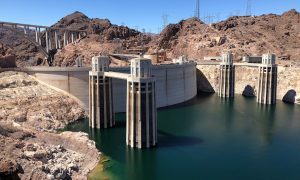- Slug: BC-CNS CAWCD Election, 580 words.
- 1 photo and caption below.
By Cole Januszewski
Cronkite News
PHOENIX – Voters in Maricopa, Pima and Pinal counties on Nov. 8 will select new board members for the Central Arizona Water Conservation District, which oversees how Colorado River water is delivered through the Central Arizona Project.
The district has increased in importance as the state grapples with megadrought and dwindling water from the Colorado River. The Southwest is experiencing its worst drought in 1,200 years. On top of that, Lake Mead sits at 1,046 feet above sea level, only 150 feet above the “dead zone” – the level where the Hoover Dam doesn’t have enough water to produce electricity. Central Arizona farmers already have endured steep cuts in water deliveries, and more pain is coming.
The Central Arizona Water Conservation District election features 14 candidates competing for five seats on the CAWCD board. Those who are elected will serve a six year unpaid term, making crucial decisions about long-term water costs and usage for 80% of Arizonans.
What is the CAWCD?
A 15-member board makes up the CAWCD, which is a special purpose taxing district that covers Maricopa, Pinal and Pima counties. The district was established in 1971 to deliver water through the Central Arizona Project, or CAP, a 336-mile system of canals. The board also is tasked with repaying the $4 billion construction costs of CAP, along with the cost of operating and maintaining the system.
CAP was founded in 1968 as a part of the Colorado River Basin Project Act, which funded multiple water projects along the Colorado River. The canals bring water from the Colorado River to 80% of Arizona residents. Construction on CAP began in 1971 and finished in 1993.
CAWCD board members are nonpartisan, with 10 members from Maricopa County, four from Pima County and one from Pinal County.
What’s the CAWCD board responsible for?
In addition to repaying the federal government and operating the canals, the board sets the rates charged to customers and levvies up to 14 cents in property taxes in Maricopa, Pima, and Pinal counties, according to the Arizona Municipal Water Users Association.
“The sole purpose of the board is to provide policy and strategic direction for the Central Arizona Project,” Lisa Atkins, immediate past president of the board, said in a CAWCD video. She also said CAP is a “huge part” of Arizona’s economy.
What issues are you voting for?
The CAWCD will lead CAP as Arizona reaches a crossroads. The state will lose 592,000 acre-feet of CAP deliveries in 2023, according to the University of Arizona’s Water Resources Research Center. The CAP says this cut represents 30% of CAP’s normal supply, 18% of Arizona’s Colorado River supply and 8% of Arizona’s total water supply. About 80% of water in Arizona goes to agriculture, according to UArizona.
The board will also have to manage CAP’s aging infrastructure, deal with rising energy costs and meet the obligations of the Central Arizona Groundwater Replenishment District, which was created in the mid-1990s to help replenish groundwater pumped by its members.
In an Arizona Clean Elections video, the CAWCD candidates presented a variety of views on how to address Arizona’s water crisis. Some focused on more efficient farming techniques, such as drip irrigation, while others focused on making the other Colorado River Basin states take more cuts to their water.
Every candidate agreed the Colorado River is running out of water, and that the critical issue is protecting Arizona’s supply from the river.
You can read more about each candidate and their positions on Arizona’s Voter Guide for the CAWCD.
For more stories from Cronkite News, visit cronkitenews.azpbs.org.
^__=
